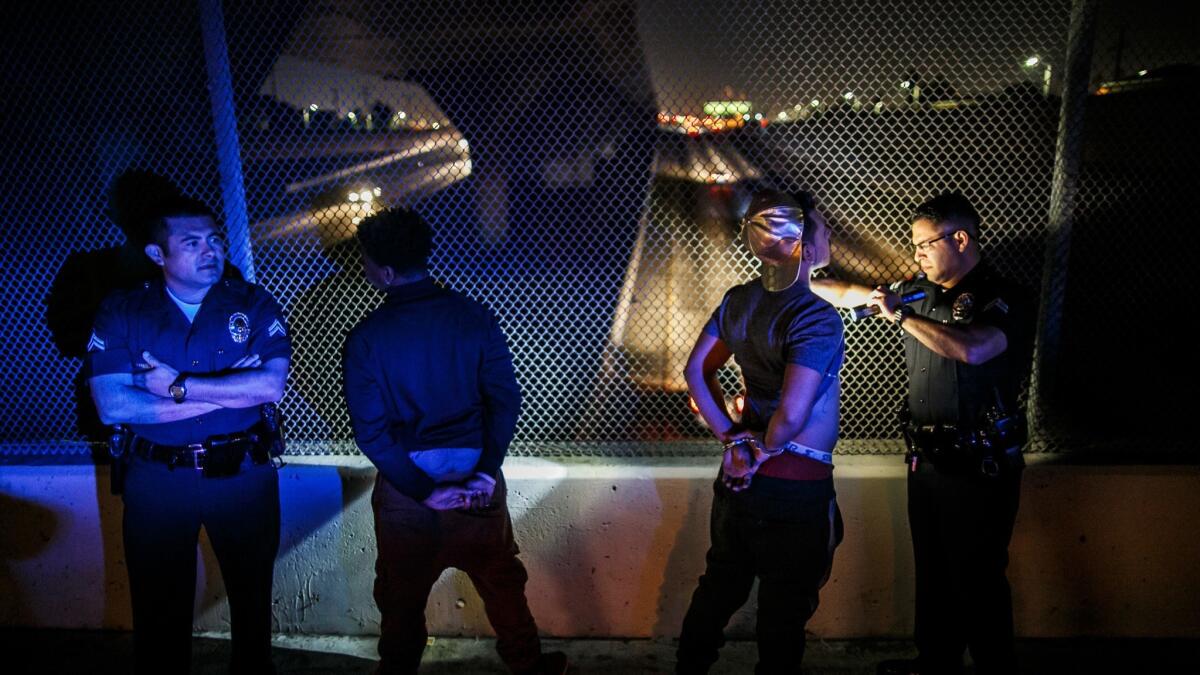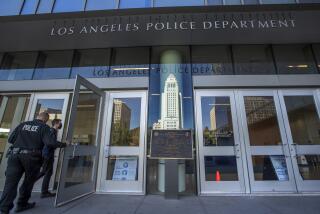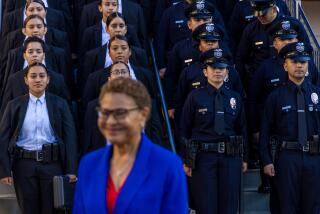LAPD chief defends Metro division after controversy over stops of black drivers

- Share via
Los Angeles Police Chief Michel Moore defended his elite Metropolitan Division officers at a law enforcement conference Thursday, saying they were not engaged in racial profiling despite a Times investigation showing that they pulled over a disproportionate number of black drivers.
He also said he will meet with community leaders, some of whom have called for Metro to pull out of South Los Angeles, to reassure them that officers are abiding by the Constitution and that the LAPD is committed to youth programs and other ways of preventing crime.
“There is a conversation … that the current presentation of data we are talking about is having a terribly corrosive effect on people of color, particularly African Americans, and that concerns me as a chief,” Moore said during an address to law enforcement leaders at the Los Angeles event.
Moore’s remarks came a day after Mayor Eric Garcetti ordered the LAPD to scale back on vehicle stops and prioritize other crime-fighting methods that will help build community trust.
Speaking to reporters, Moore said Metro was already spending less time in South L.A. after violent crime leveled off there.
“African Americans were not the quote-unquote target. And that’s my concern with the data point and how it’s being interpreted — that we just went out looking for African Americans,” Moore said. “That’s not what crime suppression was involved in.”
The Times investigation also drew the attention of U.S. Deputy Atty. Gen. Rod Rosenstein, who attended the Los Angeles Crimefighters Leadership Conference at the Skirball Cultural Center along with Moore.
In remarks to conference attendees, Rosenstein said he was “disappointed” to hear about the Times investigation, which he called a “misleading statistical analysis” and “not an accurate reflection of what officers are doing.”
Rosenstein appeared to criticize Garcetti for his reaction to the investigation.
“I would caution our political leaders — don’t jump to conclusions based on things you read in the newspaper, based on hearsay reports,” Rosenstein said. “Because those officers, the Metropolitan unit in particular, I know is tasked with doing work that is critically important to accomplish crime reduction. Not just random policing, but identifying where the crime problems are and focusing their efforts on those areas.”
In 2015, Garcetti announced that Metro would double in size to combat an increase in violent crime.
The Times investigation found that vehicle stops by Metro officers increased from a few thousand to nearly 60,000 last year.
Nearly half the drivers stopped by Metro since the expansion were black, helping to drive up the share of African Americans stopped by the LAPD overall from 21% to 28% since the Metro expansion, in a city that is 9% black.
In South L.A., which is 31% black, 65% of the drivers stopped by Metro were black, the investigation found.
Unlike regular patrol officers, Metro crime suppression officers, who numbered about 270 last year, often spent their shifts on vehicle stops and other “proactive” policing tactics intended to root out violent criminals.
They typically used a minor violation such as a broken tail light as a starting point to question the driver and potentially get inside the car — a type of stop known as a pretextual stop.
Other crime fighting strategies that Metro may use instead of vehicle stops include foot patrols, investigative follow-ups and pursuing violent crime suspects, an LAPD spokesman said earlier this week.
The database analyzed by The Times, which is available on a city website, does not show why an officer pulled over a driver. Nor can it show whether officers were engaged in racial profiling.
As required by a new state law, the department recently began collecting information about what happens to drivers after they are stopped, including whether they were searched or arrested.
In addition to the reduction in vehicle stops, Garcetti has asked for an audit of Metro stops, which the LAPD’s inspector general was already planning to do.
Police Commissioner Shane Murphy Goldsmith said she supports the mayor’s directive to immediately cut back on vehicle stops.
“I’m proud of the mayor for taking a strong and decisive stance,” she said. “We are stopping too many people of color, too many black men. The right thing to do is to recalibrate.”
Connie Rice, a civil rights attorney who has worked closely with the LAPD on reforms in recent years, said she is also in favor of “hitting the pause button.”
“You do send in Metro to do a quick dousing. Metro is critical for fast-reaction suppression,” she said. “But if it stays too long with tactics that are too broad and ensnare a lot of innocent people, you’ve got to take a look at that.”
In a written statement, the Los Angeles Police Protective League described demands from the American Civil Liberties Union of Southern California and others for Metro to withdraw from South L.A. as “criminal coddling.”
The union, which represents rank-and-file officers, “stands by the work of our Metro officers and we stand by the residents of South LA who want a safe place to live, work and raise a family,” the statement said.
More to Read
Sign up for Essential California
The most important California stories and recommendations in your inbox every morning.
You may occasionally receive promotional content from the Los Angeles Times.













